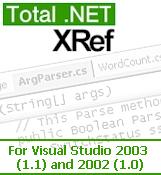 
Review: Total .NET XRef
Visual Studio Magazine, Dianne Siebold
October 2002
Total .NET XREF
Most developers agree that the one thing you can count
on with code is that it will change. When changes happen, most of us
don't have the luxury of time to go through each piece of code in a
project and find out where a certain object is referenced or used. So if
a class definition changes, we try to remember where we referenced that
particular class and hope we named it the same in all the classes. FMS'
Total .NET XRef is a code cross-referencing tool that solves this
problem.
Installing XRef is simple, but keep in mind, it works
only with the final release version of Visual Studio. XRef is a VS.NET
add-in, so it's always available from the IDE. To find out every place a
particular namespace occurs in a project, highlight the namespace name
and right-click; a list of locations appears in the XRef tool window.
The tool window displays a total count of where the specified item
appears and all the information about the object you're searching for.
This information includes the location of the file, the namespace, the
line it appears on, and a preview of that line of code. The objects you
can locate in code include variables, parameters, properties, classes,
labels, methods, operators, fields, constructors, namespaces, and
modules.
This product works with either C# or VB.NET code. XRef
parses your code as you write it so it's always up to date, and you can
search for objects at any time. There was an initial delay while XRef
parsed the code the first time I ran it in an existing project. After
that, however, I didn't see any noticeable slowing while writing code,
although FMS admits there might be a delay on slower machines. You can
disable the parser, but unfortunately, you must modify a Registry key to
do so.
One nice feature of XRef is its ability to find an
object—a class, for instance—by the class definition or by the name of
the class as it's used in code. The biggest drawback to XRef is that it
searches for a code item in only one project at a time, even if you have
multiple projects open in VS. **FMS Note - This limitation is on
namespaces only, all other code items are searched across every open
project.**
You can sort the tool window's results by any column, but you must
locate and delete two XML files to turn off the sorting. You can also
group the results grid by any column. If you have a long list of
results, XRef can filter the grid by any criteria you select. You can
also output the search results to an HTML page that's viewable and
printable from VS.NET. XRef saves the HTML report automatically to a
default directory and overwrites the report each time you create it, so
you must change the filename after running a report if you want to save
the report.
XRef is useful for speeding up development in enterprise projects.
This tool isn't an absolute requirement for development, but it can save
you time when making code changes, especially in large applications.
About the Author
Dianne Siebold is a programmer specializing in VB and
SQL Server. She's a regular contributor to VSM and the author of Visual
Basic Developer's Guide to SQL Server (Sybex). Reach her at
dsiebold@earthlink.net.
Back to Main Reviews Page
|









